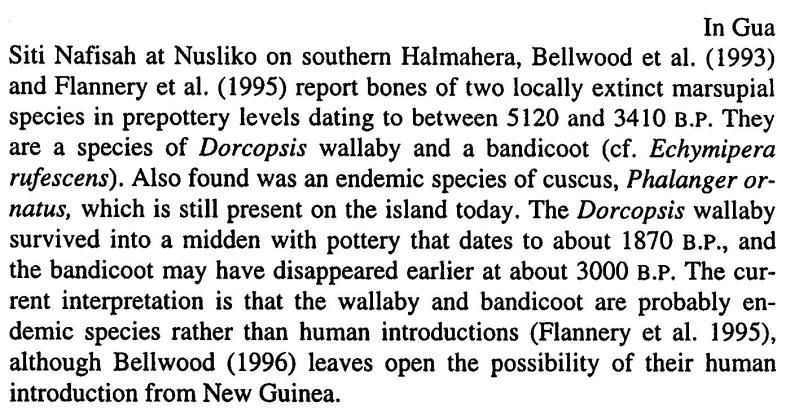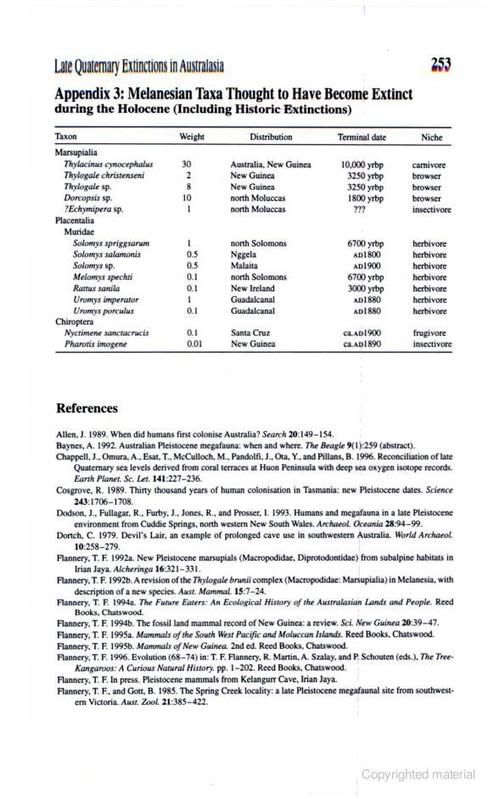Post by another specialist on Jun 30, 2009 18:12:51 GMT
Fossil marsupials (Macropodidae, Peroryctidae) and other mammals of Holocene age from Halmahera, North Moluccas, Indonesia
Authors:
T. Flannery a; P. Bellwood b; P. White c; A. Moore c; Boeadi d; G. Nitihaminoto e
Affiliations: a Australian Museum, Australia
b Archaeology and Anthropology, Australian National University, Canberra, Australia
c Prehistoric and Historical Archaeology, University of Sydney, Australia
d Zoology Museum, Bogor, Indonesia
e Balai Arkeologi, Yogyakarta, Indonesia
Abstract
Faunal remains from Gua (cave) Siti Nafisah, central Halmahera, reveal that until at least 1,870 ybp, Halmahera supported a non-volant mammal fauna which was predominantly of New Guinean origin. It consisted of at least three marsupial species; a wallaby of the genus Dorcopsis, a bandicoot (family Peroryctidae, genus indet.), and the Halmahera Group endemic cuscus Phalanger ornatus. Rattus morotaiensis, which is also endemic to the Halmahera Group, was also probably present. The wallaby and bandicoot (both terrestrial species) are now extinct, while the arboreal cuscus and rat survive. Faunal remains from the Uattamdi site, on the small island of Kayoa, do not include the remains of bandicoots or wallabies.
The Dorcopsis wallaby survived until around 1,870 years ago. It is possible that the bandicoot vanished slightly earlier. Sometime between around 3,410 and 1,870 ybp both pigs and dogs were successfully introduced. Today soricids, viverrids, cervids and several murid species, all of Asiatic origin, have established feral populations on Halmahera. The Sugar Glider (Petaurus breviceps), a marsupial which is resident on Halmahera today, is absent from the archaeological sequence, and it may be an introduction from New Guinea.
www.informaworld.com/smpp/content~db=all~content=a795082162
Authors:
T. Flannery a; P. Bellwood b; P. White c; A. Moore c; Boeadi d; G. Nitihaminoto e
Affiliations: a Australian Museum, Australia
b Archaeology and Anthropology, Australian National University, Canberra, Australia
c Prehistoric and Historical Archaeology, University of Sydney, Australia
d Zoology Museum, Bogor, Indonesia
e Balai Arkeologi, Yogyakarta, Indonesia
Abstract
Faunal remains from Gua (cave) Siti Nafisah, central Halmahera, reveal that until at least 1,870 ybp, Halmahera supported a non-volant mammal fauna which was predominantly of New Guinean origin. It consisted of at least three marsupial species; a wallaby of the genus Dorcopsis, a bandicoot (family Peroryctidae, genus indet.), and the Halmahera Group endemic cuscus Phalanger ornatus. Rattus morotaiensis, which is also endemic to the Halmahera Group, was also probably present. The wallaby and bandicoot (both terrestrial species) are now extinct, while the arboreal cuscus and rat survive. Faunal remains from the Uattamdi site, on the small island of Kayoa, do not include the remains of bandicoots or wallabies.
The Dorcopsis wallaby survived until around 1,870 years ago. It is possible that the bandicoot vanished slightly earlier. Sometime between around 3,410 and 1,870 ybp both pigs and dogs were successfully introduced. Today soricids, viverrids, cervids and several murid species, all of Asiatic origin, have established feral populations on Halmahera. The Sugar Glider (Petaurus breviceps), a marsupial which is resident on Halmahera today, is absent from the archaeological sequence, and it may be an introduction from New Guinea.
www.informaworld.com/smpp/content~db=all~content=a795082162






